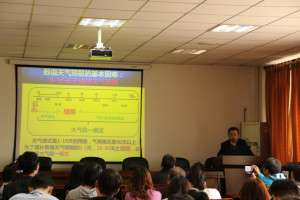Professor Zhiyong Meng, Qingxian Gao and Bizheng Wang Were Invited to Give Academic Lectures
Morning of April 16, professor Zhiyong Meng from Beijing University, researcher Qingxian Gao from Chinese Research Academy of Environmental Sciences, researcher Bizheng Wang from The Institute of Atmospheric Physics, Chinese Academy of Sciences, were invited to make academic lectures, entitled Study on the Relationship Between Rainstorm and Low Level Jet Stream in South China Warm Region, Weather Climate Background and Air Quality, The Present Situation and Trend Abroad of the Unified Model of Atmosphere, separately. This report was presided over by professor Tiangui Xiao from the School of Atmospheric Science, Chengdu University of Information Technology.
Based on the characteristics of convection and low predictability of rainstorms in the warm period of south China, professor Meng’s report studied the correlation between rainstorms in the warm period of south China and the low-level jet stream, as well as the forecast of WRF model. He divided the rainstorms in the warm period of south China into low-level-jet type and non-low-level-jet type, and analyzed the characteristic of the rainstorm according to the position of low level jet stream (850 hPa or 925 hPa). Low-level-jet rainstorm will generate strong precipitation center along the coast, which mainly comes from the 925hPa boundary layer. Low level jet streams converge as they approach the shoreline. At the same time, the forecast ability of the model to the south China warm period rainstorm and the corresponding jet stream were analyzed. The result of the model showed that it is effective to forecast the rainstorm of low level jet stream.
Gao introduced air pollution from the concept of haze pollution. He pointed out that the weather background had a great influence on pollution, and the effect of the measures taken during the APEC had lagged behind, according to the analyzed relationship between weather background and air quality based on heavy pollution processes in January 2017, and October 2015, and air quality during APEC. Then he introduced the research results on the change characteristics of the Siberian index, and the relationship between climate background and air quality.
According to the current researches and business status of numerical weather prediction, Wang drew the definition and target of unified atmospheric model. Then, he introduced the British atmospheric unified model, ECMWF next generation atmospheric unified model, the next generation of global forecast system in USA, Japan NICAM model in detail, and briefly summarized the trend of atmospheric unified model. He encouraged everyone, as long as we constantly study and improve the atmospheric model, while the scientific research process is tortuous, but the future must be bright.
After the report, the teachers and students had an active exchange and heated discussion on how to improve the model prediction scheme, how to quantitatively separate the effect of weather background from man-made emission reduction application, and the unpredictability of singularity. This exchange activity had an active atmosphere, which greatly stimulated students’ enthusiasm for exploring relevant fields.
Expert Introduction:
Zhiyong Meng: Doctoral supervisor, department of atmospheric sciences, school of physics, Beijing University. Bachelor degree in atmospheric science from Beijing University in 1991; Master’s degree in meteorology from the Chinese Academy of Meteorological Sciences in 1994; PhD in atmospheric sciences from Texas A&M University in 2007. Research interests: data assimilation, ensemble forecasting; numerical weather prediction; mesoscale dynamics.
Qingxian Gao: doctor and researcher from the Chinese Research Academy of Environmental Sciences, convener of the environmental impact study on global climate change, and expert in the quality assessment of greenhouse gas inventories at the secretariat of the United Nations Framework Convention on Climate Change (UNFCCC). Main research fields: atmospheric environment and climate change. Since joining the Chinese Research Academy of Environmental Sciences in 1996, he has been engaged in the work of atmospheric environment and climate change, and has participated in and presided over a number of national “973” program topics, national science and technology projects, state environmental protection administration and local environmental protection bureau science and technology special projects.
Bizheng Wang: He is mainly engaged in the parameterization of clouds (and their radiation) in climate models and the Semi-Lagrange Scheme. He proved that the internationally popular Semi-Lagrange Scheme which is absolutely stable is wrong in mathematics, and gave the criterion of the new stability scheme. He proposed a new bidirectional nesting scheme for global and mesoscale models in complex topographic conditions.

